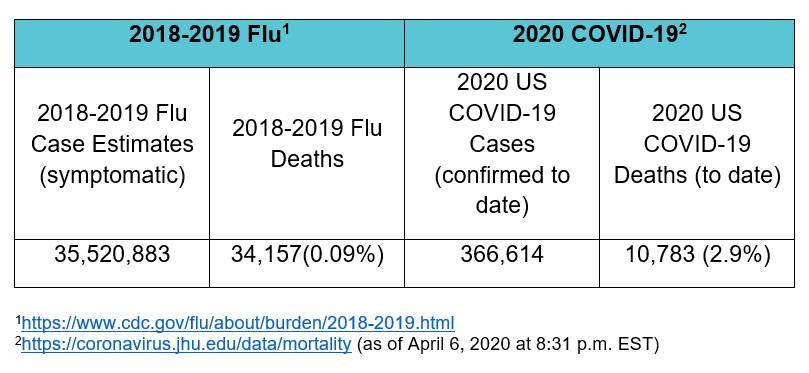
Catherine C Vick, MS and Andrew R Joyce, PhD
Venebio Group, LLC
“But the flu kills people every year.” By now, you have probably heard this. Perhaps you have argued it. We agree with you; the flu does kill people every year. We know it. We have evidence of it. We have years of data on it. We take flu very seriously and strongly recommend the vaccine for all who can safely take it. The flu, however, is not COVID-19. In our previous post on the differences in COVID-19 and flu, we looked at some of those differences, including our lack of preparation for COVID-19. Now, let’s look at COVID-19 vs the flu by the numbers. While COVID-19 is a pandemic, we will look at it from the perspective of the United States alone.

The COVID-19 totals are currently less than the 2018-2019 flu season, but keep in mind, according to the New England Journal of Medicine, the first COVID-19 case in the United States was reported on January 20, 2020. In other words, it hasn’t had a full season—it has grown from one case to 366,614 cases in less than three months, and the confirmed case death rate is many times greater than flu. For reference, flu season generally lasts around seven months, and we do not know if there will be seasonality for COVID-19. As of April 6, 2020, the Institute for Health Metrics and Evaluation at the University of Washington predicts 81,766 COVID-19 deaths by end of summer, with a possible range of 49,431-136,401. This range is a called 95% confidence interval, meaning that there is 95% certainty that the number will fall somewhere between those numbers. While the 81,766 COVID-19 death number is better than a 200,000 projection, it is not certain, and most importantly, these projections are based on full social distancing through May 2020. This is subject to change, and may need to be extended.
We remain steadfast in our message. We do not yet have a full set of tools to handle COVID-19. We do not yet have a vaccine to provide at least partial protection in advance of infection. We are all at risk; there is no herd immunity. We do not yet have medications proven to work against the virus should we become infected. And finally, we only have limited testing availability and thus cannot yet distinguish all individuals who are contagious from those who are not. At this point, social distancing and, if infected, self-quarantining are the only ways to slow the spread of the virus.
We, as a team, believe it is critical to be well-informed and follow guidelines, including, but not limited to, social distancing and good handwashing to limit the spread of COVID-19, to protect the health of our families and communities. More information on the CDC’s guidelines for the general public can be found here. We hope that one day in the future, COVID-19 will be either a preventable or treatable disease, but for now, the reality is that it is not, and it should be taken very seriously.
For more information on COVID-19 vs flu, please visit our post on the critical differences between the two.
